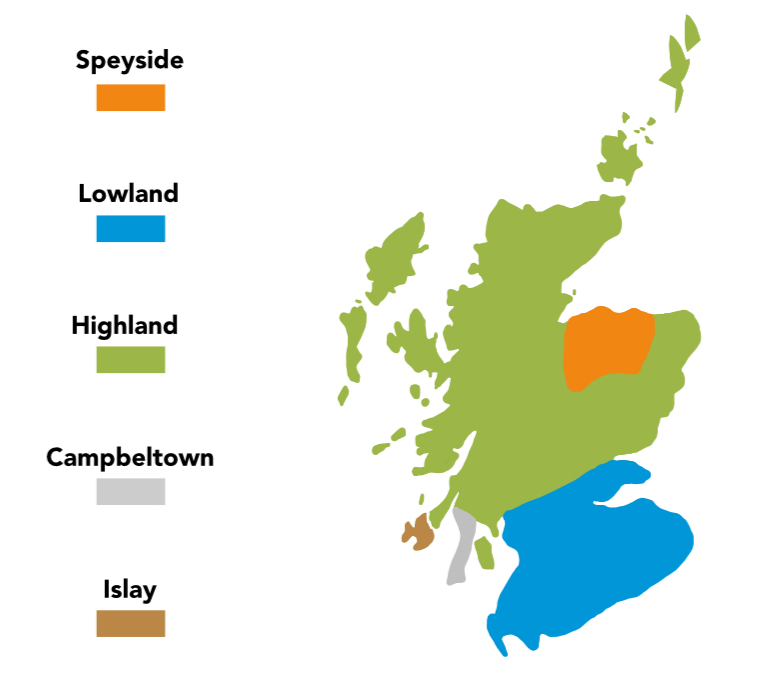My Heart Belongs to the Highlands

My partner Matt and I are currently galavanting around Scotland on our very own adults-only, whisky-centered Spring break, so of course today we’re going to talk about Scotch.
Only makes sense, right?
This week our base of operations is Inverness, Scotland, a city approximately three hours north of Edinburgh, nestled on the eastern coast and unequivocally part of the Scottish Highlands. Our plans for the week consists of three main things: hiking in the highlands, eating full Scottish breakfasts, and visiting as many highland distilleries as we can get to!
Given where we’re visiting this week, all those distilleries will be serving “Highland Scotches”. This isn't our first or even second trip to Scotland (and will definitely not be our last) and not even our first trip to the Highlands, but we will be visiting plenty of new areas we've never visited before! The Highlands are a vast and hauntingly beautiful regions, with so much to explore.
So, what constitutes a Highland Scotch? What are the distinct taste differences? Where are the boundaries? Or, if you’re entirely new to Scotch knowledge maybe you’re even asking, there are different Scotch regions??

The Scotch Map
Yes, there are different regions of whisky making in Scotland, and yes, it is important and makes a difference! Very similar to wine regions, knowing which region a Scotch comes from will give you a very good idea of what that Scotch is probably going to taste like.
There are five main regions: Campbeltown, Highland, Islay, Lowland and Speyside.
As you might be able to tell from the use of the word “regions” the distinctions between all five start with a map.

These designated regions date back to 1909 when the UK Government released a report entitled, “Royal Commission on Whisky and Other Potable Spirits” which was a comprehensive paper on both Scotch and Irish distilleries. This was the first time that Scotches were categorized into these five main sections.
It wasn’t until 2009 - a century later! - that the government published the Scotch Whisky Regulations which officially formalized three whisky regions (Highlands, Lowlands, and Speyside) and two whisky localities (Campbelltown and Islay) in Scotland. In tandem with this designation, these locations were also given European Union Geographical Indication status, which protects the “Scotch” label worldwide.
However, while the definitions started on paper, throughout the years each region became known for specific flavors and types of whisky. They’re all very different, which is what makes visiting and learning about each one something magical.

Highland Distinctions
You’ll notice from the map above that the Highlands is by far the largest region, and it actually encompasses the Speyside region!
With that visual, it may not surprise you that the flavor profiles of the Highlands Scotches are the hardest to pin down, because they are the most wide ranging. If we were to stick a throw a few descriptors out there, the most commonly used words would be: sweet, floral, fruity, nutty, and malty.
Due to the sheer size of the Highlands region, we can pretty easily break it down into smaller subregions, which then narrow down our flavor profiles.
The more northern Highlands area is known for particularly fuller bodied, rich, and sweet whiskies. This is due to the fact that - historically speaking - the Highlands distilleries used smaller still to distill their whisky, due to the scarcity of barley in that part of Scotland. Using smaller stills created as richer and heavier expression of flavor. Glenmorangie is a perfect example of this type of Scotch.
Southern Highland distilleries match up closely with their lowland counterparts in flavor profile (which makes sense since the line on the map seems fairly arbitrary between the two). This means these distilleries will produce slightly drier, much lighter, and more fruity whisky than elsewhere in the Highlands. There are great gateway Scotches! Aberfeldy is a great example of the southern Highland taste profile.
Now we move to the west. The western Highlands encompasses the Scottish Islands (minus Islay) which some say should be their own sixth distinct region. However, it also includes distilleries like Oban, which is on the mainland and still produces Island-like whiskies. These distilleries produce Scotch most similar to the Isaly scotches (which makes sense); they’re slightly peated, briny, maybe slightly oily, and can be a bit heavier.
And lastly, we head east. This includes Inverness, where we’ll be flying into, and is the area that encompasses the Speyside region. I think for this reason, the eastern Highland scotch flavor profile is the hardest to pin down. They’re herbal, they’re sweet, they’re dry, they’re fruity… they’re a bit of everything!

What Not to Miss
Honestly - I don’t know yet! Perhaps after I come home from our trip I’ll draft and update for this section. All I know right now is that the whisky is waiting and the mountains are calling.
Though we will not be making it to all these locations - that would take a lifetime, and I think is now a goal of mine - here is a list of all the current Highland Distilleries:
Aberfeldy, Arbikie, Ardmore, Ardnamurchan, Balblair, Ben Nevis, Blair Athol, Brora, Cameronbridge, Clynelish, Dalmore, Dalwhinnie, Deanston, Dornoch, Edradour, Fettercairn, Glen Albyn, Glen Garioch, Glen Mhor, Glen Ord, Glencadam, Glendronach, Glenesk, Glenglassaugh, Glengoyne, Glenlochy, The Glenmorangie, Glenturret, Glenugie, GlenWyvis, Invergordon, Loch Lomond, Lochside, MacDuff, Nc’Nean, North Pool, North Port, Oban, Old Pulteney, Royal Brackla, Royal Lochnagar, Strathearn, Teaninich, Tomatin, Tullibardine, Wolfburn

Weekly Adventure
I’m not going to tell you to go out and buy a bottle of Highland Whisky. (Scotch is expensive, man!) But I would encourage you, next time you’re out, to order a neat pour from one of the distilleries listed above! Give it a try - maybe the sweetness or dryness or fruitiness or saltiness or nuttiness or floralness of the Highlands will the Scotch profile for you!
Cheers,
Molly
References
https://www.scotch-whisky.org.uk/discover/enjoying-scotch/scotch-whisky-regions/